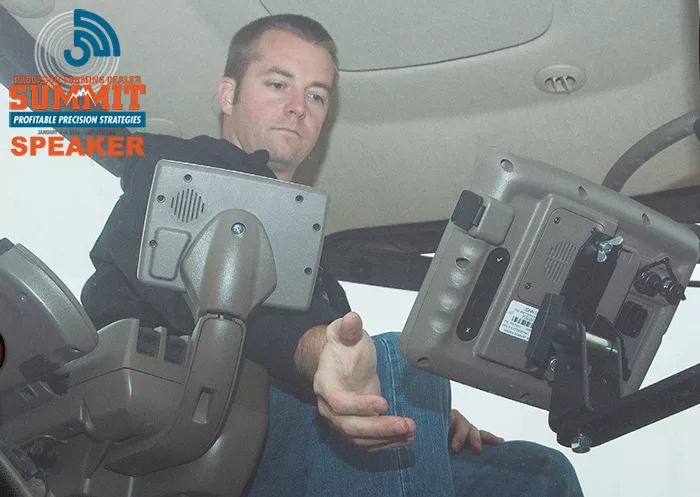Pictured Above: A day-in-the life of Phil Moskal, integrated solutions manager at Mid-State Equipment, is anything but routine. His number one goal is to keep customers happy and that requires flexibility, patience and ambition.
Whether at the dealership or on the road, Mid-State Equipment’s Phil Moskal thrives on keeping customers satisfied.
Since starting as technology editor for Precision Farming Dealer, I’ve chatted with dozens of precision specialists, visiting many of them in their native environment, and tried to share what I’ve seen and heard with our readers.
See the video series from our visit with Phil Moskal here.
But it’s one thing to spend time observing a yield monitor calibration or GPS display installation, and another to actually experience it.
This was my goal in spending a day with Phil Moskal, integrated solutions manager at Mid-State Equipment, a 6-store John Deere dealership network, based in Columbus, Wis.
Phil joined the dealership group in 2009 and serves as the primary precision specialist, mainly splitting time between the Janesville, Wis., and Columbus locations. He manages Deere’s Agricultural Management Solutions (AMS) products and services for Mid-State, which include telematics, yield mapping services and most recently, wireless data transfer of yield data.
In preparing for this assignment, it occurred to me that while I’ve been fortunate enough to listen and learn about how precision dealers are selling, servicing and supporting technology, having an appreciation for what an average day is like — if there is such a thing — would provide a more intimate understanding of the job.
After spending more than 9 hours with Phil, logging nearly 200 miles traversing south-central Wisconsin on an overcast and especially foggy early December day, making 3 customer visits and receiving one lesson in stripping tobacco, I came away with a first-hand account that to succeed as a precision specialist, it takes ambition, flexibility and a sense of adventure.
5:45 a.m. A rude awakening from my alarm clock starts the day and like most mornings, I am greeted by a whining dog and a hungry cat. Luckily, my wife and two children sleep through the commotion (as they often do).
6:30 a.m. I am out the door armed with a thermos of coffee, which gradually gets me functional during the 75 mile drive from Milwaukee to Columbus, Wis. A dense fog sticks with me the entire ride, but along the way, I still notice a handful of cornfields that have yet to be harvested, as of early December.
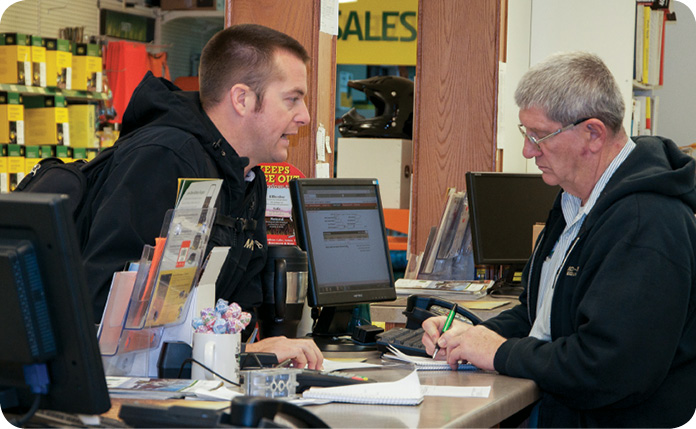
At the parts counter, Phil picks up a monitor harness to install a GreenStar 3 monitor in a new tractor cab and activate the StarFire 2 receiver. Phil checks the time on his phone and says he can’t believe it’s already after 11. “Most days, I’m so focused on what I’m doing the days just fly by,” he says.
8:02 a.m. I arrive at the dealership and immediately connect with Phil, who I’d met a few months earlier at the Janesville store. Today, we arranged to meet in Columbus, due to renovation at the Janesville location. We head straight up to the second floor conference room, which overlooks the modest showroom. Nearing the tail end of a manic and late harvest, Phil says he is happy to have a little breathing room, but he nevertheless has a busy day planned for the two of us.
The morning begins with preparing a few yield map reports. As part of its top-tier precision service package, Mid-State offers yield map transfer, organization and printing to customers. But they don’t offer any analysis of the data and prefer to be objective third parties.
8:15 a.m. Our first hiccup of the day. Attempting to transfer a customer’s yield maps via John Deere’s new wireless data transfer, Phil receives an error message when logging on to the system. He files a service request with the manufacturer and we wait to hear back. Phil has come to expect a few ‘bugs to work out,’ especially with some of the newer technology.
This particular customer has two newer S550 combines and purchased the wireless data transfer, which allowed him to link yield data online through his MyJohnDeere.com account. Ideally, Phil says this will be a huge timesaver because he won’t have to physically drive to a customer’s farm to pick up data.
8:20 a.m. While we wait for a reply, I ask Phil to give me an overview of how he prepares yield maps for customers. Once he collects the data, he loads it onto Deere’s Apex farm management software platform. From there, it’s a matter of organizing the data into a useable format for the customer. He works with all different sized farms — from 1,200 to as many as 7,000 acres.
Depending on the number of acres and whether he has to post-calibrate the data and take scale readings, each yield map report takes anywhere from an hour to a couple of days to complete.
“It’s not difficult work, but it can be time consuming,” he says. This time of year, Phil makes it a priority to collect, process and return customer yield data so they can report it to their crop insurance agents prior to the end of the year.
8:32 a.m. We are joined in the conference room by integrated solutions specialist Eric Kell, who joined Mid-State in late April. I had met Eric a few months earlier as well, at the dealership’s store in Jackson, Wis. This morning, Phil is giving him a tutorial on downloading, merging and preparing yield maps through the Apex system for a local customer with about 1,000 acres of corn, soybeans and a few custom fields. Phil walks Eric through the process step-by-step.
“All new equipment comes with telematics software, so when a new machine comes in, we’ll give it a distinct name, rather than just the serial number, because we won’t know who it belongs to,” Phil says. “It’s a lot of organization.”
9:01 a.m. Phil returns a call from a customer in northern Illinois, who had purchased a new 8320 tractor with integrated Auto-Track. But the customer couldn’t plug the GPS receiver into the tractor. After a little probing, Phil diagnoses the problem and offers a solution, which is a new adaptor harness. Rather than make the 3 hour drive to the customer’s farm, Phil has the part shipped to the dealership’s store in Salem, Wis., which is only about a half-hour from the customer.
“It wasn’t an urgent fix, but we have route trucks that go between our stores 3 times a week to move parts,” he says. “We were able to save time and fuel for both me and the customer.”
9:17 a.m. We hear back from Deere, which recommends a reinstallation of the Apex software in order to access wireless data transfer and download the customer’s yield maps. This is something Phil has done before, but it’s not always a surefire fix. If anything, he’s relieved to hear back relatively quickly from Deere, but the reinstall will take some time.
“It always depends on how backlogged they are. Sometimes, I’ll hit the submit button on the laptop and the phone rings immediately,” he says. “Other times, it’s taken 8 hours to hear back because calls are returned in their order they are received.”
Phil had hoped we could be on the road by 10 a.m. to drive to Portage, Wis., and reprogram a customer’s yield monitor.
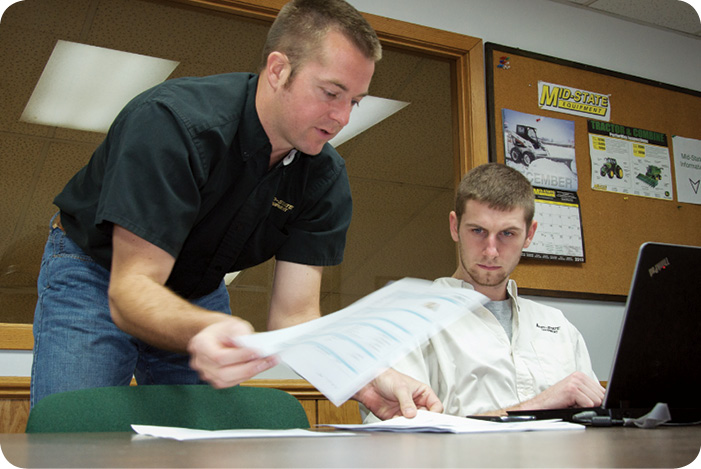
Phil trains Eric Kell, integrated solutions specialist, on how to download and organize customer yield maps, one of the services offered by Mid-State. Each year, the dealership processes tens of thousands of acres of yield maps.
9:48 a.m. Eric completes the yield maps he was working on and prints off a 37 page report for the customer. Phil says he worked on a report the day before that was more than 100 pages. Each year, they process tens of thousands of acres of yield maps for as many as 100 customers, some of whom have messier data than others.
“They only use this for maybe 4 weeks out of the year, whereas we’re immersed in this stuff everyday,” Phil says. “It’s repetition and memorization, but that is what we’re here for, to make customers’ lives easier.”
Phil tells me that more customers are starting to realize the value of annual yield reports to share with crop insurance agents and make informed purchasing decisions. Starting in 2014, Phil says the dealership will begin offering yield map printing as a separate service and charge per acre for printing and per hour for any other calibration or “map cleanup” that customers want.
9:56 a.m. Phil and I head downstairs to collect the yield map report from the printer and he introduces me to Mid-State founder Curt Hanson. He’s heading out the door to an appointment, but tells me to ask Phil for a photo he took with one of the unmanned aerial vehicles that the dealership began selling last fall. Both Curt and Phil are noticeably excited about the agricultural potential of UAVs and the sales opportunities associated with the technology, especially if usage regulations soften in the coming years.
“We only expect to sell a handful, but it’s one of the few things we can get out there and be the first ones doing,” Phil says. “Ideally, we can charge for service, but right now we’re targeting our larger customers and it serves as another connection point we can make with them.”
10:10 a.m. Phil and Eric go through the printed maps to make sure everything is accurate and also to pick out yield differentials to discuss with the customer. For this report, they notice that one corn variety yielded nearly 20 bushels per acre higher than another in the same field and will point the differential out to the customer.
“Doing this for the customer really drives home the value that this is worth the money they are paying,” Phil says. “A lot of customer tell us it’s hard to put a value on this service, because we don’t do analysis, but we just want to present the information and let them make an informed decision.”
10:16 a.m. Unfortunately, the reinstallation of Apex didn’t work, and Phil sends Deere another message seeking further assistance for the problem. Rather than wait to access wireless data transfer, the plan is to head out to the customer’s farm in Stoughton, Wis., to download the yield data this afternoon. “The day’s plan just went from A to C,” Phil says.
10:26 a.m. In between waiting to hear back from Deere again and working with Eric, Phil checks precision inventory and finds that the dealership only has 2 StarFire 3000 receivers in stock, so he places an order for 5 more units. Taking stock of inventory is something Phil does regularly, especially this time of year to plan ahead for spring.
He refers to precision sales history dating back to 2009 and compares December sales figures to determine if additional inventory is needed. Historically, the store sells 5-7 receivers during the month.
“If a customer needs to have something by year’s end and in their possession for tax purposes, we want to make sure we have it in stock,” Phil says. “In-season, I’ll check 2 or 3 times a week because it’s not like I’ll place an order, and ‘boom’ it’s here. It usually takes 3-15 days for inventory to get here, depending on how backlogged Deere is.”
10:35 a.m. A call on the conference room phone from the store’s shop reminds Phil and Eric to swing by the parts counter to pick up a monitor harness before we head out to complete a receiver and display activation on a new planter and tractor at the dealership’s lawn and garden rental location about 5 minutes away.
10:41 a.m. I get my first taste of Phil’s cell phone ring tone, AC/DC’s Back in Black, when a customer calls seeking a reactivation of his Apex software. The customer’s computer had crashed and in order to access his previously stored data, he needs to re-enter the code. Phil obliges and gets the customer reconnected in a matter of minutes. The dealership sells the Apex software for $700, but Phil points out that it’s service of the product that keeps customers loyal.
“As Deere dealers we essentially offer the same products, and across all precision brands, it’s pretty homogenous,” he says. “But service is what keeps our customers coming back.”
11:17 a.m. Phil is anxious to hit the road so we finish up in the conference room, pack up and head down to the parts counter to pick up the monitor harness. Phil checks the time on his phone and says he can’t believe it’s already after 11. “Most days, I’m so focused on what I’m doing the days just fly by,” he says.
It’s still incredibly foggy outside. Phil and I jump in his service truck and we will rendezvous with Eric at the dealership’s rental and light industrial store. This time of year, the location is partially used as a secondary setup shop for farm equipment to get machinery assembled and delivered more quickly.
I notice that Phil has a handful of mini Post-It notes on his steering wheel and dashboard. He uses these as daily reminders for appointments he has throughout the day or week. “These are my best friends and it’s my way of making lists,” he says.
11:25 a.m. We arrive and find the customer’s new 8235R tractor and 1770NT planter on the lot ready to install a GreenStar 3 monitor in the tractor cab and activate the StarFire 2 receiver. Opening the tractor cab door, we all comment on the “new cab” smell and Phil and Eric get to work attaching the monitor harness. This takes about 5 minutes and they have the display up and running soon after. On his laptop, Phil keys in activation codes for the receiver to engage auto-track and swath control for the row clutches on the planter.
He also sets up 3 homepages on the display for the customer — a guidance page, a planter page with guidance layout and a field total page so the customer can see how many acres he’s covered. “This is something I like to do based on what I think the customer will want to see most,” Phil says.
12:07 p.m. With the setup complete, we part ways with Eric who is going to drop off a couple of yield map reports to customers. Phil and I are going to make our way to Portage, Wis., to reprogram a Deere brown box mobile processor. But first, we double-back to the dealership to grab a price quote for a guidance upgrade for a customer in Poynette, Wis., where we’ll stop along the way.
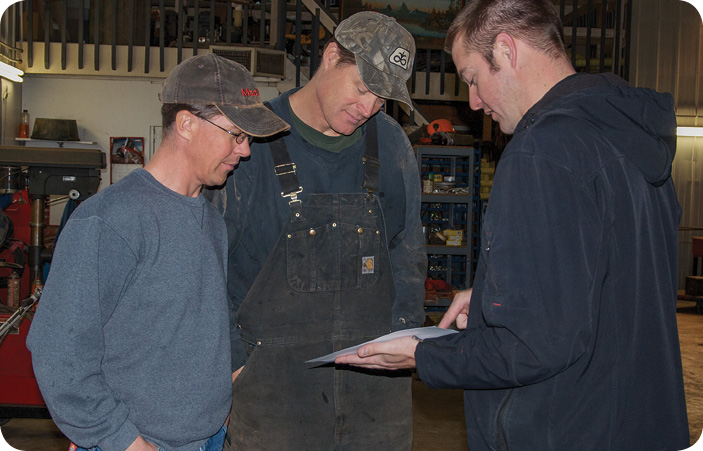
Phil explains a price quote to Scott and Larry Nelson for RowSense guidance on their corn combine and an upgrade from Deere’s 2600 to a 2630 display.
The customer is using GPS guidance on a recently purchased combine for soybeans and wants to know how much it would cost to add Deere’s RowSense and upgrade to a 2630 display for corn harvest. Phil says he tries to plan his customer visits as efficiently as possible and will try to cluster his appointments, if possible, during the day.
12:25 p.m. The day continues to fly by and before it gets too late in the afternoon, Phil offers to stop for lunch. I’ll usually try to steer clear of the empty calorie meals, but McDonald’s fit the bill today with 2 cheeseburgers and a medium peppermint mocha. Phil packed his own lunch — as he often does — a turkey sandwich (not leftover from Thanksgiving). We eat on the road.
12:55 p.m. We arrive at Nelson Grain Farms and Phil introduces me to Scott and Larry Nelson. We step into their workshop where Phil discusses a price quote for RowSense guidance on their corn combine and an upgrade from Deere’s 2600 to a 2630 display. The quote for the package is about $1,000 more than what the two men tell Phil they were looking to spend.
Phil says he will talk with sales department and see what he can do, then fields a few more questions about the value of the upgrade. The conversation is light and familiar, very much like old friends talking to one another. Phil offers to collect the Nelson’s yield map thumb drives to take back to the dealership and process. He’ll also clear off old data from the thumb drives.
1:35 p.m. We hop back in the truck and Phil checks in with the customer in Portage to give him an estimated time of arrival and to find out where the combine will be parked so we can easily find it.
I ask him how he thought the visit with the Nelsons went. Even if they didn’t immediately upgrade their guidance system, Phil says it was a worthwhile stop because they’ve also expressed interest in purchasing the Apex software.
“They had never done any mapping before, so with the new combine purchase we rolled it in this year and I’ll print off the maps so they can see them,” Phil says. “It’s a service they will appreciate, so maybe next year they will decide to purchase the software and pay for the convenience of having the maps printed and delivered.”
2:05 p.m. We arrive in Portage. There’s no sign of the customer, but we find the combine tucked in a shed. The customer is looking to purchase the combine, and had the weather cooperated, he’d have been out harvesting today.
“This was kind of a last minute setup because with harvest dragging on, the customer wanted a bigger combine to get more done,” Phil says. “He doesn’t have guidance. He just wants yield monitoring.”
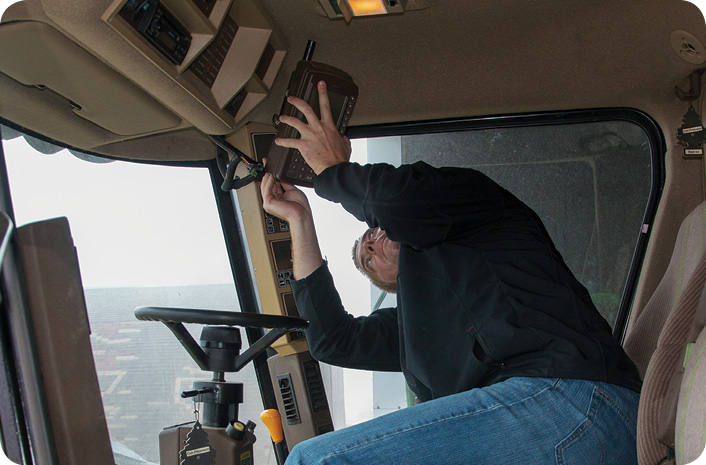
Phil programs a John Deere brown box to record corn yield and moisture. The setup takes about 10 minutes and he says it’s become a lot easier to adapt older technology or equipment to work together.
Although the previous combine owner traded it in with a 2600 display, this customer wants to use his brown box mobile processor, rather than upgrade. I admit to Phil that I haven’t seen many of Deere’s brown box units up close and he says he doesn’t deal with them too often. The dealership only has one brown box display they use for programming.
2:10 p.m. We hop into the combine cab and Phil gets right to work programming the brown box to record corn yield and moisture. The setup takes about 10 minutes and he says it’s become a lot easier to adapt older technology or equipment to work together.
“It would be nice if everyone bought new equipment every couple of years and rolled down the used equipment, but we still have to have a place to go with it,” Phil says. “We’re a lot more able to accommodate customers who want features on used equipment, beyond what it was initially intended to do.”
2:35 p.m. It’s back on the road to Stoughton, where we’ll pick up the yield data Phil had unsuccessfully tried to transfer this morning. Rather than wait to try and transfer the data another day, Phil says the customer will appreciate the in-person effort to get the maps sooner rather than later.
On the drive, Phil mentions that one of his favorite parts of being a precision specialist is getting to be a problem solver for customers and interacting with them. It’s evident that Phil relishes being on the road, despite the somewhat solitary nature of the job.
3:17 p.m. We pull into D&D Olson Farms. With no sign of owners Dave or Dale Olson, we head straight to the equipment shed and find the 2 Deere S550 combines that Phil needs to download the yield monitor data. The downloads take about 5 minutes each and Phil grabs the thumb drives. He keeps a Ziploc bag full of extra thumb drives in his service truck, just in case he or a customer needs one. But he always makes sure to individually label each one with the customer’s name, so as not to confuse them.
3:31 p.m. As we’re about to head out, Dave Olson pulls up in an RTV hauling a trailer of tobacco leaves. Phil introduces me and Dave invites us into a curing box for a lesson in stripping tobacco. Neither Phil or I have experienced the process, so it was an education, to say the least. As soon as Dave opens the door, the scent of tobacco is potent.
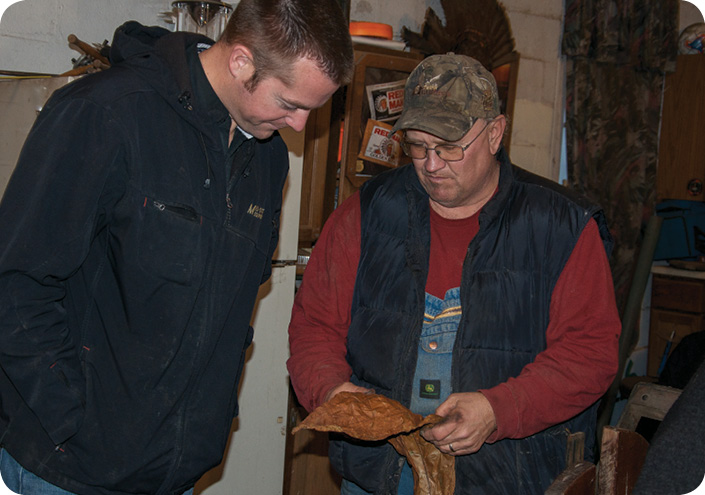
Phil and I get a lesson from precision customer Dave Olson in stripping tobacco. Neither Phil or I have experienced the process, so it was an education, to say the least. As soon as Dave opens the door to the curing box, the scent of tobacco is potent.
The Olsons only grow about 7 acres of tobacco and sell the harvest to Red Man for a few thousand dollars each year. During the tutorial, Phil and Dave talk about this year’s corn and soybean harvest and the Olson’s post-calibrated maps revealed crop yield averages of 193 bushels per acre for corn and 55 bushels per acre for soybeans. Phil will send the Olson’s yield report to their crop insurance agent and the data will be used to develop variable-rate planting maps for spring.
3:48 p.m. The fog and drizzle make it seem darker than it really is at this point in the afternoon, as Phil and I make our way back to the dealership in Columbus. Again, Phil comments on how fast the day has gone. While the day didn’t go quite as planned, he calls it a success. “If you can’t be flexible and change your day to accommodate customers, you won’t last long in this job,” he says. “You have to be able to adapt and learn on the fly. As long as you don’t push customers off, it’s always manageable.”
4:37 p.m. We pull into the dealership as it begins to rain. Phil and I head into the store to pick up a yield map report he will drop off at a customer’s farm on his way home tonight.
4:45 p.m. We’re about to part ways for the day, when a delivery of Mid-State’s 2014 customer calendars arrives and it’s all hands on deck to unload the shipment. We haul the majority of the boxes into the dealership, but load 9 boxes into Phil’s service truck, so he can deliver them to the Janesville location in the morning.
5:07 p.m. I thank Phil for an educational and inspiring day and jump in my car to head back to Milwaukee with a fuller appreciation for a day in the life of a precision farming specialist.

